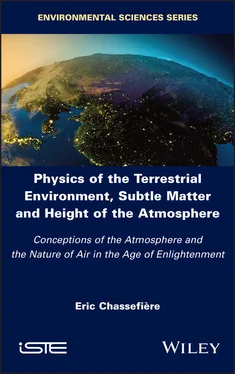1 ...8 9 10 12 13 14 ...18 As we have seen, this is the explanation given by Halley and Homberg for the formation of the vapors. Thus, it is the addition of igneous particles to water molecules, resulting in the heating of these molecules and their rarefaction, which results in their evaporation, in air heavier than they are. The author of the entry, on the observation that “ice evaporates even in the most severe cold”, and also that condensed particles (clouds) are not lower in winter than in summer, rejects this explanation of evaporation due to the effect of igneous particles making water molecules lighter than those in the air. His explanation is that water dissolves in the air, just as salt dissolves in water. Dissolving in air makes water invisible, just as salt dissolving in water becomes invisible. He therefore considers air as a solvent, all the more effective in dissolving water when it is heated, especially by the vapors themselves in contact with the evaporable body. To the objection made to his theory that evaporation also occurs in a vacuum, he replies that the space above water cannot be completely empty of air:
According to the experiments of some physicists, water evaporates in a vacuum; it can therefore rise without the help of air, without being supported by it, as I said in the state of dissolution. But if the physicist had paid attention to the fact that water contains an immense quantity of air from which it cannot be entirely purged, and that it cannot evaporate without the air it contains developing, he would easily have noticed that this objection contains a paradox, and that it is impossible for a space containing water that evaporates to remain perfectly empty of air.
Thus, in the middle of the 18th century, there was still uncertainty as to the exact nature of the vapors and exhalations, whose mechanisms used for lifting, dissolution in the air or lightening by the igneous particles joined together, were the subject of controversy. It follows from the preceding analysis that the word “vapor”, as used in the first part of the 18th century, should not be taken in the sense of water vapor (or vapor formed from liquid matter in general) in its gaseous form, but rather small particles of water (or liquid) rising in the atmosphere from the Earth’s water, or any other liquid, which evaporates. These lighter than air particles rise in the atmosphere to the level where they are in equilibrium with it, and can be transported there by the wind. They can also lead to the formation of fogs or clouds. The entry NUÉE (FOG) in DUF-1727 says, on this subject: “As the subtle and rarefied vapors are the matter of the winds, also the vapors tightened and condensed form fogs and rain; hence the rain usually brings down and soothes the wind”. Fog (which can be identified with clouds floating in the lowest region of the air) rises to different heights, as the entry NUÉE (FOG) in the Encyclopédie states:
Fogs rise in our atmosphere at different heights. We sometimes see them suspended, one above the other, and they seem very distinct, which depends mainly on the difference in their specific gravity [their density], which keeps them in balance with the air, which is more or less dense. We know that they are suspended one above the other by the different routes they take, with one being carried higher and the other lower, without mixing together. It is said that the highest fogs rarely rise above the height of the tops of the highest mountains; for one can usually see from afar that these peaks rise above the clouds. (2) We learn from various observers who have been on the highest mountains that they have always seen the fogs floating below them, without ever noticing that they are above their heads. Riccioli has calculated that the highest fogs never rise to the height of 5000 steps [≈3000 m]. However, there could perhaps be some subtle exhalations that rise much higher.
As for the dissipation of fog, this takes place through rain, but not exclusively in this way. It can also be dislocated by the wind, or dissolve in the air in proportion to the purity of the air when it rises in the atmosphere due to a local increase in pressure.
Vapors rising from humid bodies, and the exhalations that are the equivalent of them applied to dry bodies, produced, respectively, by evaporation and exhalation, are therefore rather ill-defined substances, of a rather more liquid nature (in the sense of cloud particles) than of a gaseous nature (in the sense of air molecules) in the minds of the scientists of the time, although the gaseous nature is correctly perceived by some of them in the process of evaporation. The supposed liquid nature of vapors is a legacy of the Aristotelian vision, which attributes to vapors, and not to air, the ability to refract light and enlarge the Moon close to the horizon, just as water enlarges by refraction the image of the stick immersed in it. We will generally speak of vapors and exhalations to designate all the marine and terrestrial emanations present in the atmosphere, which are not necessarily transparent to light, as we have detailed. In some cases, the word vapor will be used to describe all emanations, including exhalations.
1.4. Coarse and subtle matters
Besides vapors and exhalations, we have seen that heterogeneous air contains another type of substance, namely “the matter of light or fire, which emanates perpetually from celestial bodies; to which some physicists add the magnetic emanations of the Earth, true or alleged”. These subtle substances, of which there are many other kinds, play a fundamental role in the representation of the atmosphere in the 18th century, as we will see in the chapters devoted to them. But first, we must define what matter was considered to be at the time in the most general sense. We find a definition of matter in the entry MATIÈRE (MATTER) of the DUF-1690:
First principle: substance whose mixture, or bond, composes all natural bodies […] Celestial matter is very subtle and liquid: it rotates and carries with it the globes of the planets […].
The raw matter is that which one conceives by making abstraction of all its various forms. […]
Extent, divisibility, figure, and impenetrability are essential properties of matter. Extent is conceived before the other three, and therefore extent is what constitutes the essence of matter. It is certain that the idea of extent is inseparable from matter: and as soon as no extent is conceived, no idea of matter remains. It is disputed whether matter is infinitely divisible. The subtlety of philosophers has made the question problematic. Rohault posits the divisibility of matter to infinity.
The celestial matter in question is the ether. Matter, characterized by its four properties, of which “extent” is the predominant one is, according to the Cartesians, is a first principle, a substance that enters the composition of all natural bodies. The question of its divisibility, which placed Cartesians and atomists at odds, was considered problematic. The only addition to this definition in DUF-1727 concerns movement: “Some have argued that movement is essential to matter, and that all its parts have always been in motion, and cannot be otherwise.” The Encyclopédie gives the following definition of matter , which effectively includes the notion of motion under the term mobility:
substance extended, solid, divisible, mobile and passible, the first principle of all natural things, and which by its various arrangements and combinations forms all bodies.
The pre-eminence of extent was questioned by some authors, such as Samuel Clarke, because “if extent were the essence of matter, and therefore matter and space were one and the same thing, it would follow that matter is infinite and eternal, that it is a necessary being, which can neither be created nor annihilated, which is absurd.” Thus, in Clarke’s Newtonian conception, impenetrability is the essence of matter:
Читать дальше











